Proper Posture Cycling – Tips for All New Riders
We all know that cycling is the perfect way to enjoy being outdoors and get in some exercise at the same time.
But did you know that having proper posture on your bike is key to getting the most out of your rides – and helps you avoid injury?
I sure didn’t when I first started riding!
In this article, we will look at ways to achieve the proper posture for cycling so that you can be more comfortable and ride like a boss.
You sure don’t want to be hunched over your bike like some old lady! Your back gets really pissed off about this.
Keeping your spine straight is key – no slouching or over-arching is allowed!
A neutral spine means your weight is evenly distributed – taking pressure off your back and neck.
You’re not a robot, so don’t ride like one.
A relaxed upper body helps you to avoid tension and discomfort.
So, put those shoulders down and keep a slight bend in those elbows. Your arms and wrists will thank you as you glide over those bumps in the road.
Let’s take a look at some cycling posture tips on how you can find that sweet spot for your cycling success!
This post contains affiliate links. As an Amazon Associate, I earn from qualifying purchases. This means I may earn a commission, at no extra cost to you, should you choose to make a purchase using my link.
Understanding Correct Cycling Posture
Remember that we are all built differently so proper posture for cycling will look different for all of us.
It can also look different depending on which type of cycling you prefer – road cycling with more aggressive posture; hybrid cycling (this is me) more of an upright posture and mountain bikers that can use several different postures depending on the terrain.
However, the basics – I have found – are pretty much the same.
The Importance of Proper Posture
Maintaining proper posture is so important for anything we do, sitting, standing, walking, any physical activity, and cycling is no exception.
Correct cycling posture is essential in reducing fatigue, ultimately leading to longer, more comfortable rides.
Don’t underestimate the importance of proper posture in cycling.
Make it a habit, and enjoy better and safer rides.
What is Correct Cycling Posture?
Correct cycling posture is pretty simple but so important.
It just requires you to keep a relaxed, comfortable position on the bike.
I mean – you don’t want to be too relaxed and slumped over, but you also don’t want to be all tensed up with a white knuckled grip on your handlebars either!
- Your posture should be upright, with your back straight and your shoulders relaxed.
- Your arms should be slightly bent, with your elbows tucked in close to your body.
- Your hands should be resting lightly on the handlebars.
- Your knees should be in line with your feet, with your feet resting flat on the pedals.
- Your hips should be level, with your weight evenly distributed between the seat and the handlebars.
- Your head should be level, with your eyes focused on the road ahead.
Benefits of Correct Cycling Posture
Maintaining proper cycling posture offers a range of benefits, including:
- Increased comfort and reduced fatigue
- Improved efficiency and performance
- Reduced risk of injury
- Increased control and stability on the bike
So, the next time you hit the road, remember to focus on your cycling form and technique and enjoy the ride!
The Importance of Bike Fit
Getting the right bike fit is crucial for maintaining proper posture.
We all have different body shapes and sizes, and finding the right bike fit can make all the difference.
If your bike is too big or too small or your seat or handlebars are off – your body will be all wonky.
When it comes to bike fitting, the most important thing to consider is frame size.
To determine the correct frame size, you need to consider your height, inseam length, and riding style.
Seat height is another important aspect of bike fit. If your seat is too high or too low it can cause discomfort and pain in the knees, hips, and lower back.
The correct seat height is determined by your inseam length (inner thigh at the crotch to foot) and the angle of your knee when the pedal is at the bottom of the stroke.
Reach and handlebar position are also important when getting the right bike fit.
The reach refers to the distance between the seat and the handlebars, and it can affect your comfort and ability to control the bike.
The handlebar position can be adjusted to suit our riding style, whether you prefer a more upright or leaned over position.
Don’t be afraid to stop by your local bike shop – a professional bike fitter can help you find the right frame size and can also help you get set up in the right position with your seat and handlebars.
This way the bike will fit your body perfectly.
Optimal Body Positioning
Let’s dive into the key elements of upper and lower body positioning.
Upper Body Positioning
Maintaining a relaxed riding position is very important for a comfortable ride.
You should try to keep your back straight but relaxed, and your shoulders down and back. This will help to prevent tension in the neck and shoulders, which can cause pain and fatigue.
To achieve this position, keep your core engaged and your elbows slightly bent. This allows for a slight shock absorption to help reduce the impact of bumps on the road.
Also, try to keep your wrists relaxed and in line with your forearms, to avoid any unnecessary bending or twisting.
Lower Body Positioning
For a more comfortable ride that doesn’t wear you out quickly, your lower body positioning is key.
Start by making sure that your hips are positioned towards the back of the seat and your knees are aligned over the pedals when sitting.
This engages your strong glutes and hamstrings – your backside – to generate force.
When standing, shift your weight forward and keep your hips centered over the pedals to maintain balance and control – especially on tricky terrain or those hills – that at the time look like Mount Everest!
Preventing Strain and Discomfort
It’s important to maintain proper cycling posture to prevent strain and discomfort.
Here are some tips to ensure a comfortable ride:
Adjust the Bike Seat
The bike seat should be at a height that allows your knees to fully extend when pedaling.
If your hips rock side to side, the seat is too high.
Adjust the seat so that your feet are in the proper pedaling position, with the balls of your feet over the pedals.
This will prevent strain on your knees and ensure an efficient pedal stroke.
Maintain Proper Posture Cycling
Keep your back relatively straight, but not locked or tensed into a line.
Avoid letting your back round outward, which can cause strain and discomfort over time.
Engage your core muscles to support your back and maintain proper posture.
Check your Bike Fit
Make sure your bike is properly fitted to your body.
A professional bike fitting can help ensure that your bike is adjusted to your body’s proportions and prevent strain and discomfort.
Avoid Neck Pain
Cycling places a lot of stress on the neck.
To avoid neck pain, make sure you have proper posture and bike fit.
Keep your head up and your eyes looking forward, rather than down at the ground.
If you’re experiencing neck pain, try adjusting the height of your handlebars to reduce strain on your neck.
Flexibility and Strength Training
When it comes to cycling, having good flexibility and muscle strength is so important.
It will help you to maintain good posture on your rides.
This is why cross training is so important for any cyclist.
Try incorporating yoga or pilates and a weight training program into your cycling routine.
It can make a world of difference!
Here are some exercises I like to do to help improve my flexibility and strength for cycling.
Flexibility
Flexibility is essential for cyclists because it helps us to avoid injuries and maintain the correct posture on the bike.
Here are a few stretches that you can do to improve your flexibility:
Hip flexor kneeling stretch:
1. Kneel with your left knee on the floor and your right leg at a 90-degree angle in front of you.
2. Put your hands on your right knee and keep your back straight.
3. Keeping your left knee pressed to the floor, lean forward into your right hip while squeezing the muscles in your left buttocks.
4. Hold for 30 seconds. Repeat on the other side.
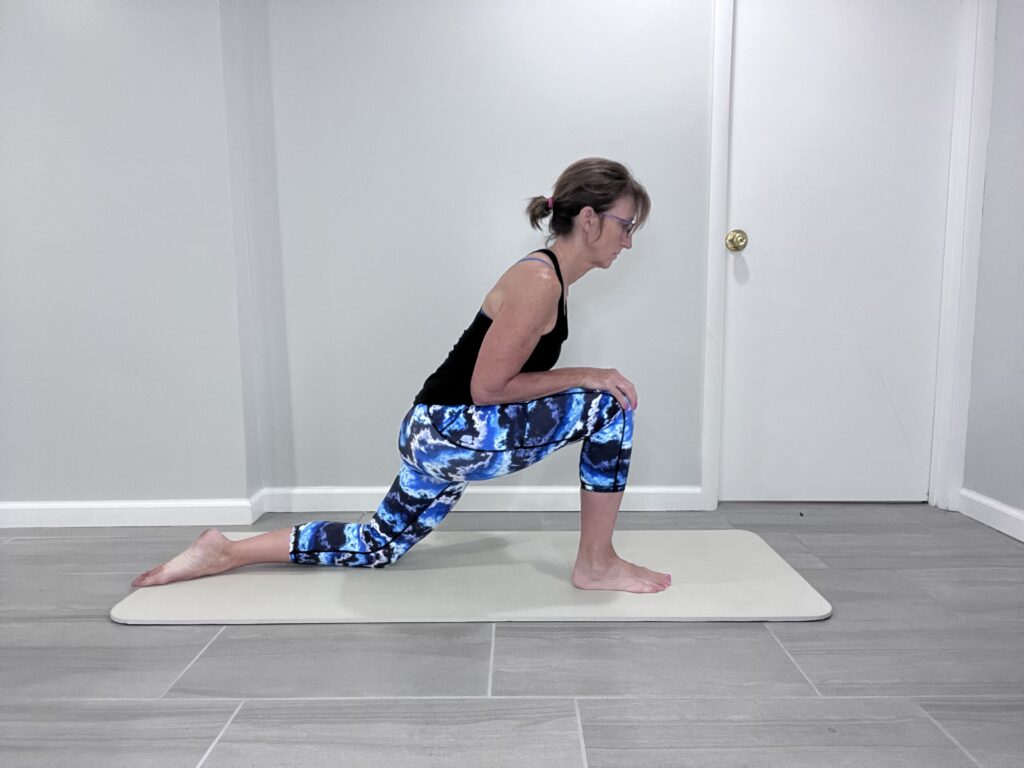
Hamstring stretch:
1. Sit on the ground with both legs straight out in front of you.
2. Lean forward and touch your toes.
3. Hold for 30 seconds before switching sides.
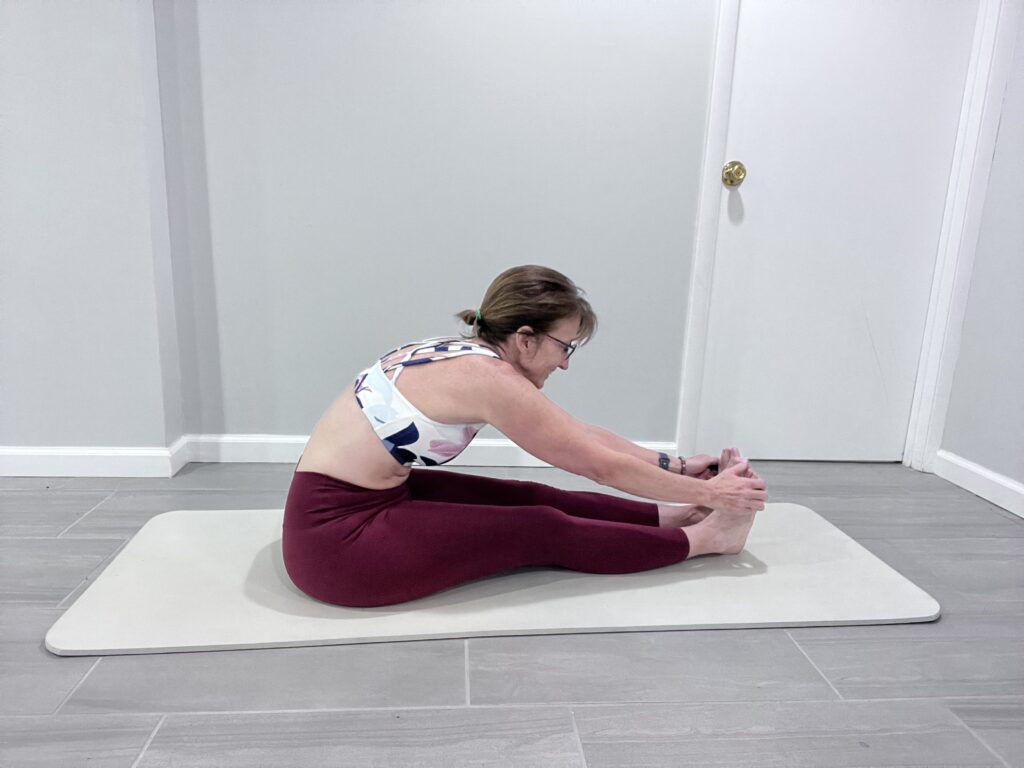
Quad stretch:
1. Stand with one hand on a wall for support.
2. Bend one leg and grab the ankle with the same hand.
3. Hold for 30 seconds before switching sides.
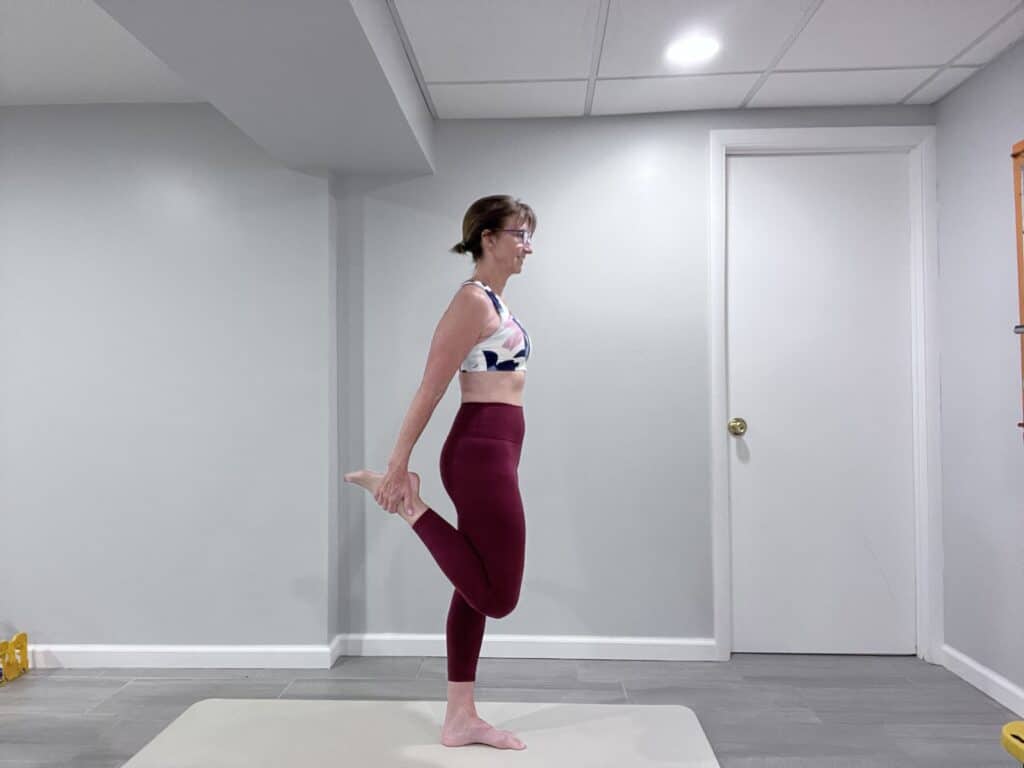
By adding these stretches into your routine, you can improve your flexibility and avoid injuries while cycling.
Strength Training
Strength training is also important for cyclists because it helps us to increase your ability to power the bike and maintain the correct posture while riding.
Here are a few exercises that you can do to improve your muscle strength:
Squats:
1. Stand with feet shoulder-width apart and squat down as low as possible.
2. Keep the back straight and the knees in line with the toes.
3. Repeat for 3 sets of 10 reps.
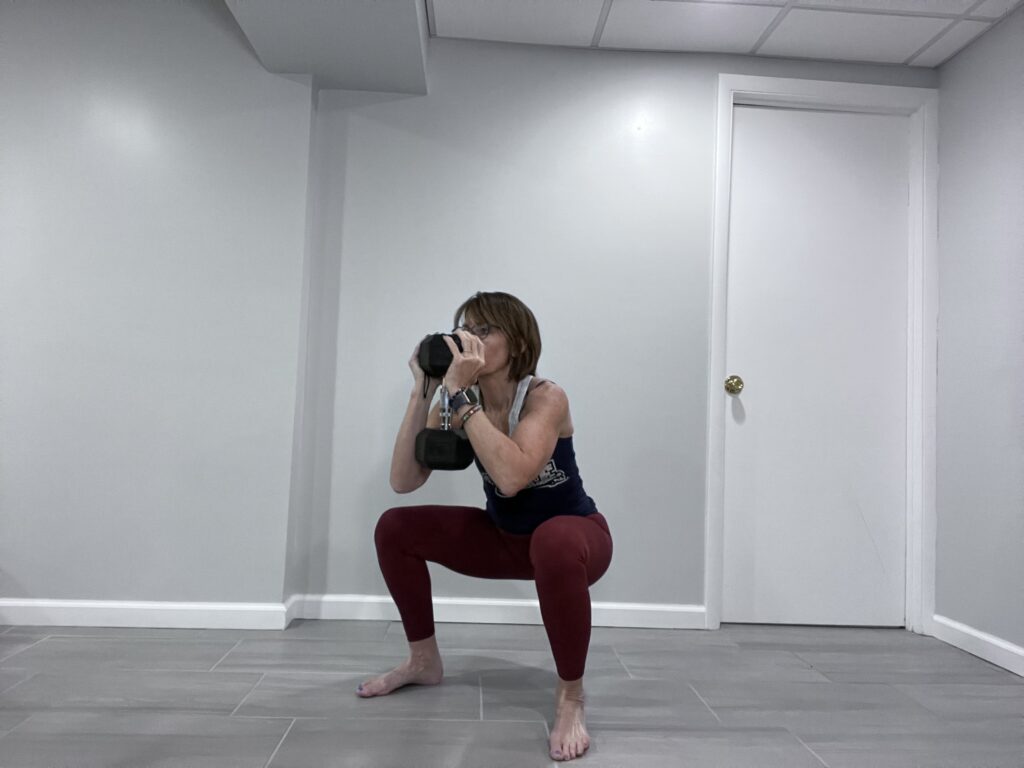
Lunges:
1. Stand with feet hip-width apart and step forward with one leg.
2. Bend both knees to 90 degrees and then push back up to the starting position.
3. Repeat for 3 sets of 10 reps on each leg.
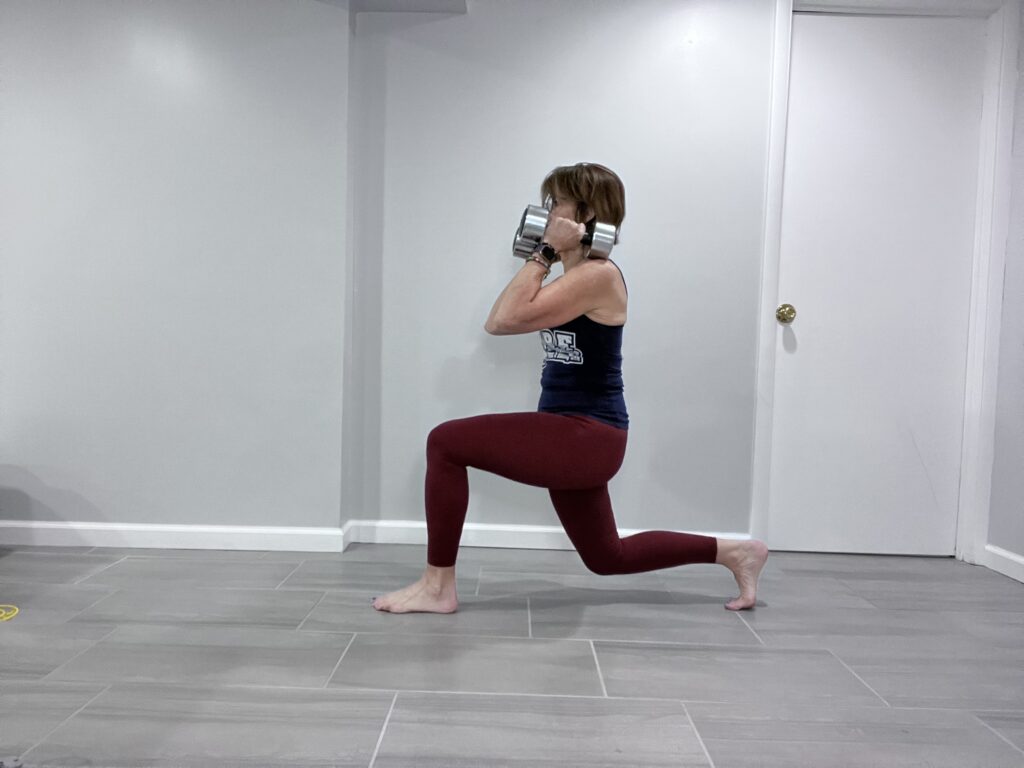
Plank:
1. Start in a push-up position with the forearms on the ground.
2. Keep the back straight and hold for 30 seconds before resting.
3. Repeat for 3 sets.
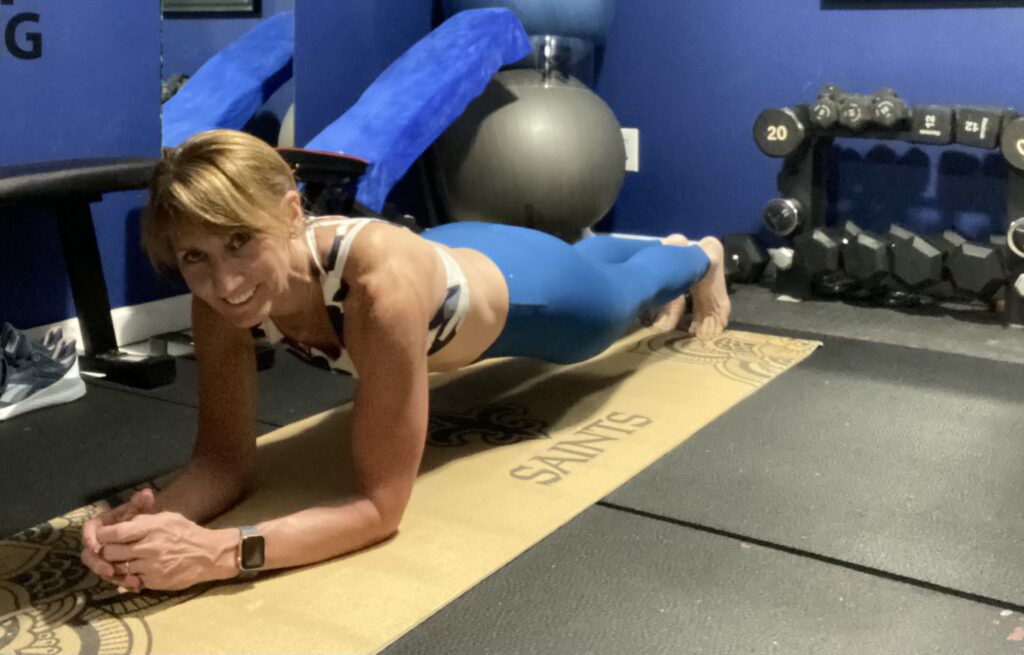
By incorporating these exercises into your routine, you can improve your muscle strength and increase your power output while cycling.
Conclusion
Taking care of your cycling posture is one essential step in ensuring both a safe and comfortable ride.
Proper alignment, balance, power, and control are vital components to ensure the most comfortable bike riding posture for riding.
In addition to basic bike fit adjustments, you should also be sure to incorporate exercises that help improve any weaknesses or misalignments caused by bad posture habits.
Not only does this give you as a rider an extra edge in producing more efficient pedal strokes, but it also helps you stay injury-free and healthy.
Now that you’re armed with tips and advice for improving cycling posture, what are you waiting for?
New and returning cyclists alike can benefit from these techniques – so get pedaling!
